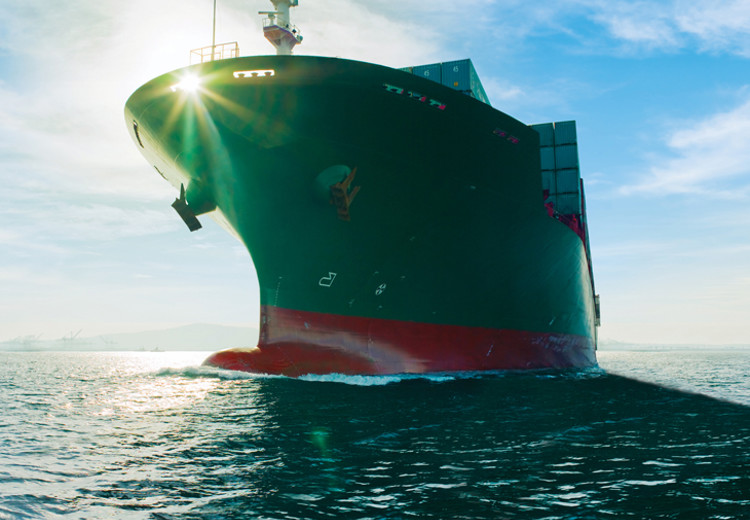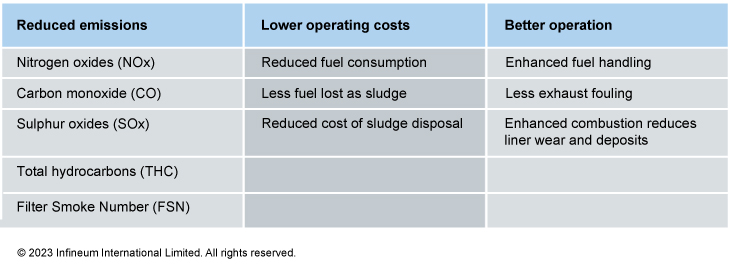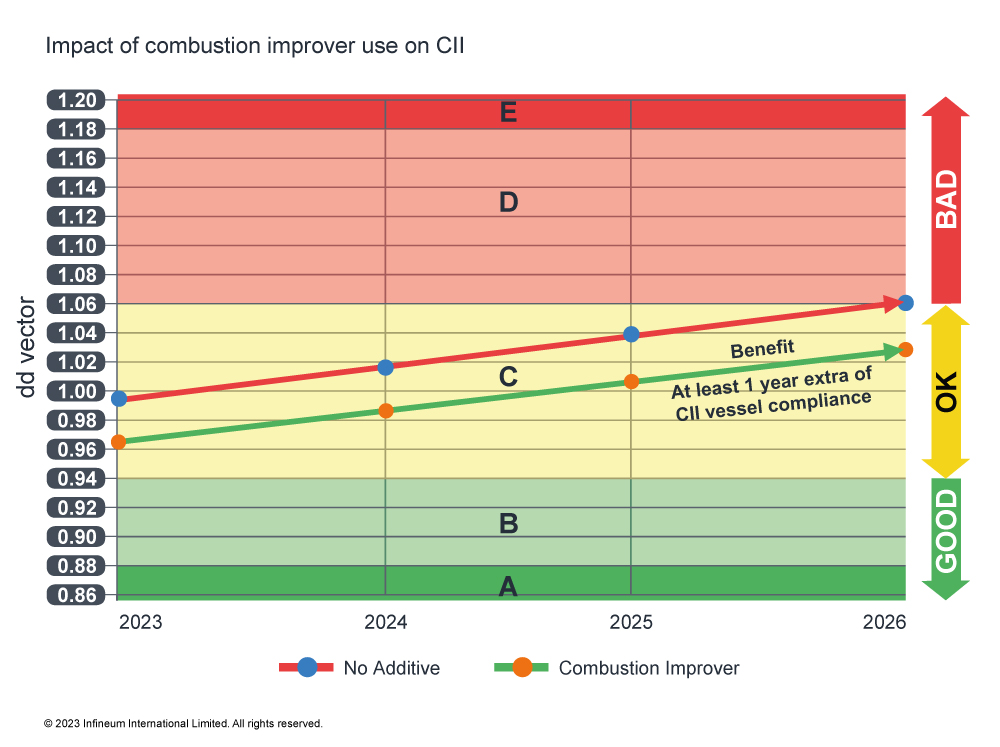Marine engines
Pioneers of maritime decarbonisation
15 May 2025
09 June 2023
Fuel consumption savings help vessels towards environmental compliance without CAPEX

With shippers underway on the first data collection for the new Carbon Intensity Indicator, they are looking for ways to improve fuel economy to ensure they achieve a rating of 'C' or better. Federico Vidili, Infineum Global Fuel Additives Marketing & Sales Advisor, explores how the use of advanced combustion improver additives can be an easy to implement solution that offers benefits beyond efficiency gains.
From January 1 2023 it is mandatory for all ships, 5,000 gross tonnage and above, to initiate the collection of data to enable their annual operational Carbon Intensity Indicator (CII) and rating to be established. Click here to read more about CII.
A ship’s CII rating is a measure of efficiency and is based on fuel consumption, which is directly related to the amount of CO2 it emits. But improved efficiency and reduced carbon emissions are also important, as sustainability and environmental responsibility are now high on the agenda of most shipping companies, and increasingly valued by their customers.
CO2 emissions can be influenced by a number of factors including, for example, ship operation, power optimisation, drag reduction, fuel and additive selection. Some of the largest reductions in CO2 emissions can be made by switching to low or zero carbon fuels such as 3rd generation biofuels, synthetic fuels, hydrogen and ammonia. However this may not be as straightforward as it sounds, with a number of issues preventing a quick switch including:
And, on top of these challenges, with fuel accounting for 50 – 60% of the total operating costs of a vessel, the current high cost associated with some of these new fuel options makes them unattractive.
Given the demand for lower running costs, improved efficiency and reduced emissions, Infineum has invested in the development of marine combustion improvers. These fuel borne additives offer an immediate, zero CAPEX, easy to implement performance improvement for existing fuels, which reduces CO2 emissions to contribute to an enhanced CII rating.
In static engine testing we have observed statistically significant fuel savings vs. non-additised fuels. These results have been confirmed in field trials onboard a 33,000 deadweight tonnage chemical tanker, where a Specific Fuel Oil Consumption (SFOC) saving of 1% has been achieved.
Because they provide a quick and affordable option, combustion improver additives can help the marine industry to start its decarbonisation journey today. In addition, these proven chemistries will help bridge the gap while we wait for better availability of alternative fuels, for relevant engine technologies to evolve, while more efficient hardware is deployed and until new more efficient builds enter shipping fleets.
Infineum marine combustion improvers have demonstrated cleanliness credits in both field trials and static engine environments. We have also observed several further benefits during our extensive testing programmes.

With further regulatory pressure on emissions expected in the second half of this decade, the ability to reduce exhaust emissions without CAPEX will be increasingly important to realise.
Saving fuel means there is also an opportunity to exploit the Carbon Credits Trading system to gain further financial benefits for fleets. For example, a mid-sized container ship saving 1% of fuel can reduce its CO2 emissions by 750 tons/year.
The EU will include shipping in its Emission Trading System (EU ETS) from 2024. EU ETS will be applied to ships above 5,000 gross tonnage (GT) transporting cargo or passengers for commercial purposes. The EU monitoring, reporting and verification (MRV) system will be extended from 2025 to apply to offshore ships above 400 GT and general cargo ships between 400 and 5,000 GT transporting cargo for commercial purposes. Implementing a strategy for the coming years will be a fundamental step for ship owners to both mitigate emission and take advantage of Carbon Credits.
Maintaining the initial CII rating may be challenging for many operators. It has been reported that CII is already having an effect on the sale & purchase of ships. Since the introduction of CII, vessels operating in band C are losing up to 15% of value in comparison with vessels with a CII in band 'A', particularly in the tanker market. It has been suggested that vessels in band 'A' could increase their value up to 7%.
However, the CII contains improvement goals that are designed to encourage ship owners to consistently work on their fleet-wide operational efficiency. To do this it will be important to have a plan to continuously improve CII in the next few years to match new stringent regulations already planned.

A benefit of the use of combustion improver additives is demonstrable through lower fuel consumption per nautical mile year-by-year. To that effect, they can become an integral part of achieving the annual energy efficiency/operational CII in the Ship Energy Efficiency Management Plan (SEEMP Part III).
On the route to decarbonisation, combustion improver additives have a key role to play. By providing an easy to implement CO2 emissions reduction strategy today they can contribute to an improved CII rating, without the requirement for CAPEX, while also helping to reduce operating costs.
Sign up to receive monthly updates via email